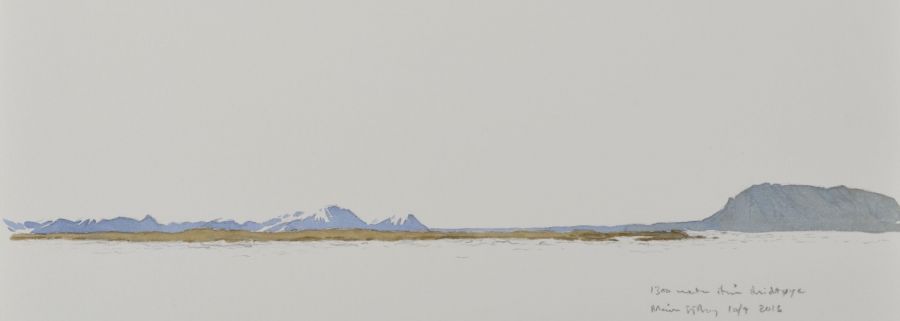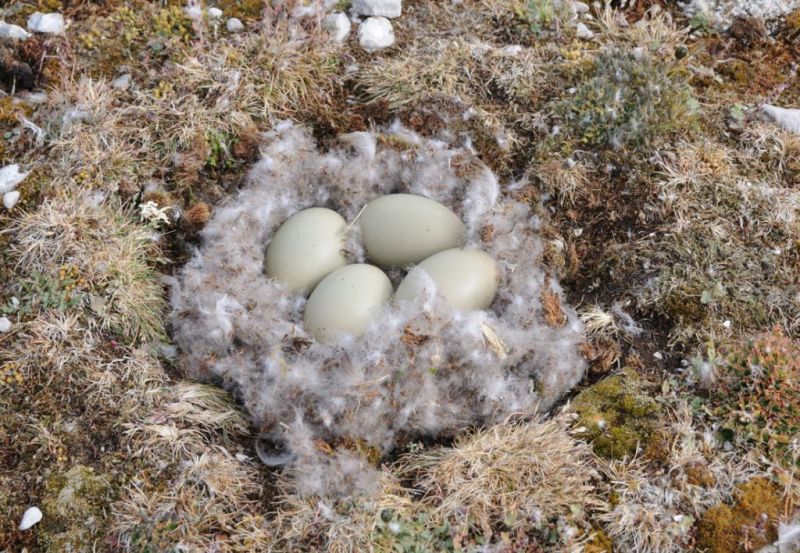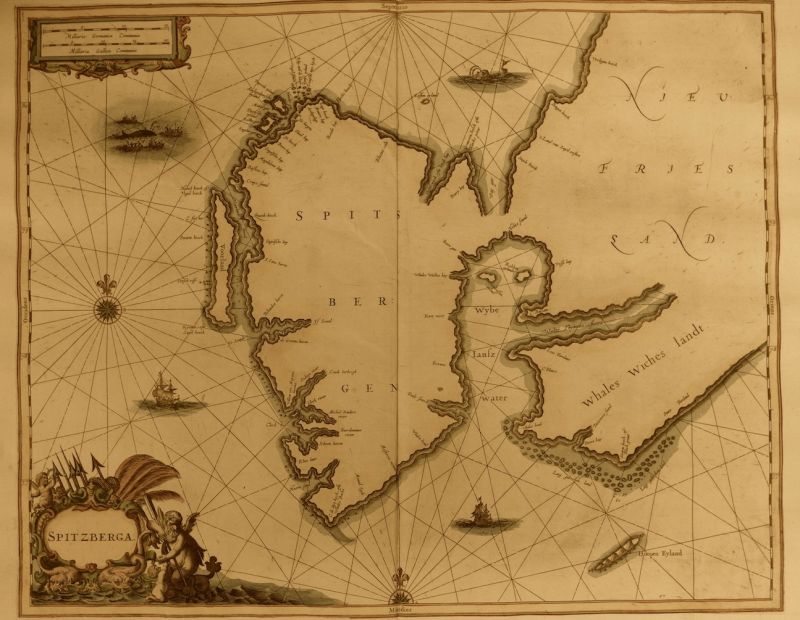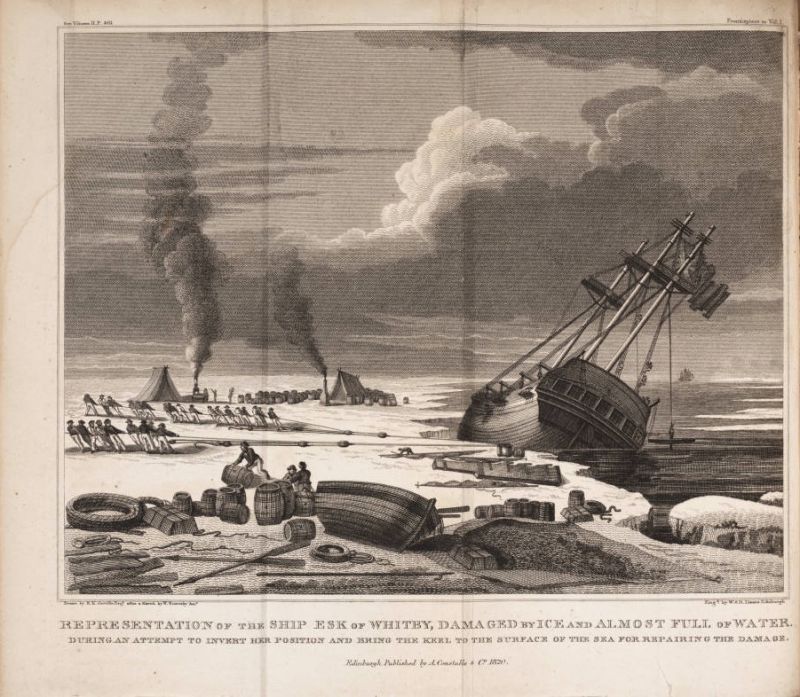ikfoundation.org
Promoting Natural & Cultural History



ESSAYS |
EIDERDOWN, WOOLLEN CLOTHES & FURS
– Practical aspects on Journeys to Spitsbergen 1750s to 1820s
In the year 1758 an opportunity arose for a naturalist to accompany a whaling ship towards the North Pole – Carl Linnaeus and the Royal Swedish Academy of Sciences became interested in having natural specimens collected from such a distant place. His former student Anton Rolandsson Martin was seen as a suitable candidate and he agreed to embark on the voyage in the same year. Rolandsson Martin was granted 600 Rixdollar copper coins by the Academy to carry out the journey and was lent necessary scientific instruments such as thermometers and a compass. His diary and autobiography also include some notes about suitable and unsuitable clothing as well as gathering of eiderdown. These mid-18th century Arctic observations together with contemporary correspondence etc have helped rediscover historical details of everyday life and travel, when being further compared with experiences learned from earlier and later travellers alike.
 The voyage may have lasted only three months, mainly spent at sea, except for going ashore for a few hours, but even so Rolandsson Martin is still today regarded as an important scientific pioneer by later Arctic explorers and natural historians. Via recent research by the IK Foundation’s, Bridge Builder Expeditions in 2016 and 2017, it has been established that the location of his visit was the levelled coastal landscape on one of three small islands of Forlandsøyane, situated west of Spitsbergen – here depicted from the distance of 1300 meters. (Courtesy of: Watercolour by Måns Sjöberg, Bridge Builder Expeditions – Voyage I, September 2016).
The voyage may have lasted only three months, mainly spent at sea, except for going ashore for a few hours, but even so Rolandsson Martin is still today regarded as an important scientific pioneer by later Arctic explorers and natural historians. Via recent research by the IK Foundation’s, Bridge Builder Expeditions in 2016 and 2017, it has been established that the location of his visit was the levelled coastal landscape on one of three small islands of Forlandsøyane, situated west of Spitsbergen – here depicted from the distance of 1300 meters. (Courtesy of: Watercolour by Måns Sjöberg, Bridge Builder Expeditions – Voyage I, September 2016).The whaling ship as Anton Rolandsson Martin boarded in Göteborg harbour was listed in the local ‘Götheborgs Weko-Lista’ (Weekly List of Gothenburg) as: ‘Monday 17th April 1758. Departing ship. Commander Jean Dirck Classen to Greenland on whale fishing…’. However, the ship named de Visser (The Fisherman) was unsuccessful in catching whales this year. This fact was listed in the same local paper at their return: ‘From the West arriving ships. The skipper…Jean D. Claesen from Greenland with ballast…’ (31 July 1758), and likewise noted in the foreword of Rolandsson Martin’s diary. Furthermore in a letter from Carl Linnaeus to the Dutch botanist Johannes Burman, 4 October 1758, was mentioned that Anton Rolandsson Martin had returned from Spitsbergen on a whaler and had found very few plants, but several beautiful marine animals.
That Rolandsson Martin suffered unusually from the cold and found it difficult to keep warm is made evidently clear in his accounts that have been preserved. The problem was basically that from the very beginning he could not afford to buy enough clothes in readiness for such a northerly voyage. His autobiographical notes, dated April 1758, before the voyage mention: ‘My clothes consisted of a long overcoat which I never removed because of my tattered breeches and clothes, a sealskin cap with ear flaps I wore on my head and boots on my feet; nobody but me knew that there were no stockings underneath them’. As the ship sailed further and further north the cold worsened, the thermometers constantly showing temperatures below and well below freezing, albeit the months of May and June. He experienced the cold penetrating all his clothes day and night, and he and the crew took bits of fur and wigs to help keeping their heads warm.
 During the few hours on land Rolandsson Martin primarily paid interest to eiderdown, botanical matters and rock samples. Because of being so light and soft eiderdown is regarded as particularly valuable, while at the same time providing greater feelings of warmth and comfort as filling material in clothing, bed cushions etc. In his diary from 1758 Rolandsson Martin described his own experience of eiderdown from Spitsbergen, as follows in the foreword: ‘On the small green islets, the eider birds (Anas mollissima) laid their eggs by the thousand in nests on the softest down that the female plucks from her underbelly and from which the most expensive eiderdowns are made’. (Eiderdown and eggs. Courtesy of: Queen’s University, Kingston, Canada, electronic source).
During the few hours on land Rolandsson Martin primarily paid interest to eiderdown, botanical matters and rock samples. Because of being so light and soft eiderdown is regarded as particularly valuable, while at the same time providing greater feelings of warmth and comfort as filling material in clothing, bed cushions etc. In his diary from 1758 Rolandsson Martin described his own experience of eiderdown from Spitsbergen, as follows in the foreword: ‘On the small green islets, the eider birds (Anas mollissima) laid their eggs by the thousand in nests on the softest down that the female plucks from her underbelly and from which the most expensive eiderdowns are made’. (Eiderdown and eggs. Courtesy of: Queen’s University, Kingston, Canada, electronic source).Today that sought-after down is harvested after the fledglings have left the nest; on an 18th century voyage that was not quite the case. Additionally on 1st July 1758, the diary included: ‘Within a short time we had shot 30, collected half a barrel of down and over 1. barrels of eggs’. In the bitter cold the travelling group were not only interested in the eiderdown as material for stuffing their pads and bolsters, but the eggs and the birds also served as a good dietary addition to their household. They even used the rougher feathers after having plucked the eider; of them they made a kind of breast-plate which was said to be quite warming. The quills may have been poked closely together into a piece of cloth to form a warm shield, which was placed inside the outer layer of clothing in order better to preserve the warmth. The 18th century travellers in that area had to seize every possibility they could muster to keep the cold at bay, the quills being of assistance in their case.
However, Forlandsøyane or Prins Karls Forland was known long before 1758 as the place first was described by the Dutch explorer Willem Barentsz in 1596. Some years later, the English explorer Jonas Poole in 1610 and 1612 mentioned that English whale hunters were referring to the island as Prince Charles' Foreland, after King James’ son, Charles. Due to the increasing hunt for whales during the 17th century, activities on and around the islands situated west of Spitsbergen became quite frequent, mainly for that currents and winds making this to a natural seafaring route in these waters. The usefulness of eiderdown was also mentioned in the journal by Frederick Martens from his voyage to Spitsbergen in 1671, originally published in German 1694, a much later translation to English was published by the Hakluyt Society in 1855. The detailed observations from this geographical area gives a glimpse into the trade in down, the use of down and egg by the seamen etc during the 1670s:
 Undated (17th century) map of Spitsbergen, demonstrates the significance of a quite accurately depicted Forlandsøyane/Prince Charles' Foreland – here named ‘Voorland’ – for the early seafarers. (Courtesy of: Svalbard Museum, Longyearbyen, Svalbard. Map Collection).
Undated (17th century) map of Spitsbergen, demonstrates the significance of a quite accurately depicted Forlandsøyane/Prince Charles' Foreland – here named ‘Voorland’ – for the early seafarers. (Courtesy of: Svalbard Museum, Longyearbyen, Svalbard. Map Collection).'The Kirmews and mountain-ducks, and also the strund-jagers, make their nests on low grounds (that one would think the high water must needs run over them), on the small islands, where they are secure from the foxes; but not from the white bears, for they swim in the water from one island to the other. We took up great store of their eggs. The nests of these birds are not all made after the same manner. For the mountain-duck makes its nest of the feathers of its own belly, mixing them with moss. The feathers of these nests are not the eider down brought us from Island, for that cometh from great birds (that the inhabitants there call eider), and costeth, when it is cleansed from the moss, a crown a pound, as I have been informed; but the feathers of the mountain-ducks of Spitzbergen, which they call down, the seamen put into their pillows and straw sacks, which if they should be cleansed would be more worth.’
Whilst whale hunting ships much later, as described by William Scoresby the Younger in his travel journals, also visited Forlandsøyane in the early 19th century. Landings or close sailings to the islands were mentioned to have taken place in 1809 and next time first on 17 July 1818 in calm weather:
‘At 6 am. we got sight of the land & lay too, the atmosphere being very hazy, Somewhat clearer at noon, stretched inshore until we could see the beakers [sic] upon some rocks from the deck, when we had 35 fathoms water; tacked & lay too. Considerable sea. The land nearest to us proved to be the middle hook of the Foreland. Steered NNE 6 miles & were then becalmed. Soundings 35 fathoms rocks. Thick fog. A breeze at NNW took us off shore a few miles when we tacked.’
 The journals kept by William Scoresby the Younger from 1811 to 1820 together with his notebooks for 1821 and 1822 both listed and gave some further notes of used working dress. In an edition printed 1820 this representation of one of his journeys in the 1810s, gave among many matters some insight into to the almost uniformly chosen canvas trousers, woollen jackets and caps being worn by the seamen who took part on this northerly travels during the spring and summer months. (From: Scoresby, W…1820, frontispiece).
The journals kept by William Scoresby the Younger from 1811 to 1820 together with his notebooks for 1821 and 1822 both listed and gave some further notes of used working dress. In an edition printed 1820 this representation of one of his journeys in the 1810s, gave among many matters some insight into to the almost uniformly chosen canvas trousers, woollen jackets and caps being worn by the seamen who took part on this northerly travels during the spring and summer months. (From: Scoresby, W…1820, frontispiece).William Scoresby the Younger sailed to the Arctic on his father’s whaler when only ten years old and continued these voyages every summer until his mid-thirties. His regular journals from 1811 to 1820 principally describe navigation, the weather and the work involved in catching whales during these expeditions, but also include a few passing notes on clothes. While in command in April 1813 he made some interesting observations about the need for warm clothing on board:
‘...the sailors found the change of climate so considerable as to induce several of them, to add an additional covering of a wig to their heads, mitts to their hands, and a Flushing Jacket to their Backs & Shoulders. A pair of capacious Boots were likewise worn by some. There is something ludicrous in the Costume of a Greenland sailor, to appearance Good looking, healthy, Young Men, clothed in such Coarse Materials...as Cow Tail wigs, Flushing extra jackets; large Fishermen’s Boots a yard or stockings, perhaps two pairs of mitts, one of yarn the other of leather or water proof sealskin – these with some other minor articles form a dress warm & Comfortable to the feelings but odd & fantastical to the eye...’
Evidence of clothing are not only possible to trace via images and written journals, archeological finds being another important source for the understanding of working dress in this area. However, these finds are in the main predating the mid-18th century with 50 years or more, including some garments and a multitude of cloth fragments from archeological grave finds and discarded rags etc from the Dutch whalers staying over the summers at Smeerenburg and other locations on Spitsbergen. These finds kept by Svalbard Museum, include everyday garments of wool and linen (seldom preserved) which originally were worn by working men; like five knitted caps, a black felt hat, wide knee-length trousers, stockings and garters – all of wool. Another group of grave finds kept at the museum, originates from Russian seafarers and hunters dating ca 1690-1820. This collection includes quite an extensive fragmented material once used for clothing – mainly tabby and twill woollen cloths, felted qualities and leather.
To conclude it was necessary to wear the warmest possible woollen clothes made from strong thick homespun, and knitted, preferably double-layered, woollen garments as well skin material to keep warm in the freezing temperatures of the Arctic spring and summer. Even if the crew and adjoining naturalist et al were aware of the Arctic conditions (the average temperatures being lower from 1750 to 1820 than in present-day), the temperature and ice conditions could change from one year to the next. The year 1758 when Anton Rolandsson Martin travelled for instance, seems to have been colder than usual resulting in that the sea water west of Spitsbergen froze earlier than the commander of his ship had expected. Due to the intense cold during several months at sea, staying warm therefore being one of the main aims and of great importance for one’s health. Financial limitations prior to the journey, like for Rolandsson Martin, unavoidably became a problem throughout the sailing. He and many others had to be inventive to stay as healthy, dry, comfortable and warm as possible. Whilst an ideal planning for such a northerly sea voyage included a much more substantial number of garments for all possible events. Linen shirts, woollen jackets, breeches, waistcoats, coat, wide cape, 5 to 10 pairs of socks, boots and shoes for change – to be worn in various layers and combinations to be suitable in all from calm spring days when setting out on the voyage to well below zero degrees in stormy Arctic weather conditions.
This essay is part of the ongoing textile and natural history project: ‘Personal belongings and collections on 18th century travels’.
Sources:
- Götheborgs Weko-Lista, No.16: 17 April 1758 & No.31: 31 Julii 1758 (quotes translated from Swedish).
- Hagström, Jonas, ‘Where Swedish polar research began – the Linnaean apostle Anton Rolandson Martin’s voyage to Spitsbergen in 1758’. Polar Record, 2018 pp. 1-7.
- Hansen, Lars, ed. The Linnaeus Apostles – Global Science & Adventure, London & Whitby 2007-2012 (Vol. Two pp. 15-46 Anton Rolandsson Martin’s diary).
- Hansen, Viveka, The Textile History of Whitby 1700-1914 – A lively coastal town between the North Sea and North York Moors, London & Whitby 2015 (More info about William Scoresby’s observations on clothes, pp. 175-178).
- Hansen, Viveka, Textilia Linnaeana – Global 18th-century Textile Traditions & Trade, London 2017 (pp. 197-201).
- Jackson, C. Ian, ed. The Arctic Whaling journals of William Scoresby the younger, Vol. I. The Voyages of 1811, 1812 and 1813, Hakluyt Society, London 2003.
- Jackson, C. Ian, ed. The Arctic Whaling journals of William Scoresby the younger, Vol. III, The voyages of 1817, 1818 and 1820, Hakluyt Society, London 2009.
- Kungliga Vetenskapsakademien, Centrum för vetenskapshistoria, ms Bergius, Stockholm, Sweden (Royal Swedish Academy of Sciences): Rolandsson Martin, Anton, manuscript; ’Självbiografiska anteckningar’.
- Martens, Friderich, Friderich Martens vom Hamburg Spitzbergische oder Groenlandische Reise Beschreibung gethan im Jahr 1671, Hamburg (Bibliothek Zürich).
- Rolandsson Martin, Anton, ’Dagbok hållen vid en resa till Norrpolen eller Spitsbergen, på Kongl. Vetenskapsakademiens omkostnad och med ett Grönländska compagniet i Göteborg tillhörande skepp är 1758 förrättad.’, Ymer tidskrift, Stockholm 1882.
- Scoresby, William, An Account of the Arctic Regions, with a History and Description of the Northern Whale Fishery, Edinburgh 1820.
- Svalbard Museum, Longyearbyen, Svalbard. (Visit to Exhibitions, Map Collection, Textile Collections & information about the collections by Curator Sander Solnes. December 2016).
- The IK Foundation website: (Bridge Builder Expeditions: Spitsbergen).
- The Linnaean Correspondence, Online. (Letter/L2444. Carl Linnaeus to Johannes Burman, 4 October 1758).
- White, Adam, Ed., A Collection of Documents on Spitzbergen & Greenland, Hakluyt Society, London 1855 (p. 61).
ESSAYS
The iTEXTILIS is a division of The IK Workshop Society - a global and unique forum for all those interested in Natural & Cultural History from a Textile Perspective.
Open Access essays - under a Creative Commons license and free for everyone to read - by Textile historian Viveka Hansen aiming to combine her current research and printed monographs with previous projects dating back to the late 1980s. Some essays also include unique archive material originally published in other languages, made available for the first time in English, opening up historical studies previously little known outside the north European countries. Together with other branches of her work; considering textile trade, material culture, cloth manufacturing, fashion, natural dyeing and the fascinating world of early travelling naturalists – like the "Linnaean network" – from a Global history perspective.
For regular updates, and to make full use of iTEXTILIS' possibilities, we recommend fellowship by subscribing to our monthly newsletter iMESSENGER.
been copied to your clipboard




– a truly European organisation since 1988
Legal issues | Forget me | and much more...
It is free to use the information/knowledge in The IK Workshop Society so long as you follow a few rules.
 LEARN MORE
LEARN MORE









